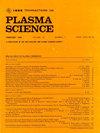Impact of Atmospheric Pressure Nonthermal Plasma on Curcumin-Loaded Polyvinyl Alcohol/Chitosan Polymer Films for Controlled Drug Release Application
IF 1.3
4区 物理与天体物理
Q3 PHYSICS, FLUIDS & PLASMAS
引用次数: 0
Abstract
The challenges in traditional drug delivery systems are increasing everyday which should be overcome by polymer-based controlled release systems. The utilization of nonthermal plasma has become pivotal in altering polymer surface properties and finds extensive applications in biomedical fields. In this study, surface properties of curcumin-loaded PVA/chitosan films were altered by atmospheric pressure dielectric barrier discharge (DBD) plasma at 25 kV for various discharge gases and exposure durations. Contact angle measurement confirmed that argon and helium plasma treatment significantly enhanced the wettability of polymer films from 89.16° to 32.73° and 27.28°, respectively. The introduction of new functional groups, alterations in surface morphology, and surface roughness values after plasma treatment was analyzed by Fourier transform infrared (FTIR), X-ray photoelectron spectroscopy (XPS), scanning electron microscopy (SEM), and atomic force microscopy (AFM) analyses. Optical emission spectroscopy (OES) identifies reactive species in the argon and helium plasma environment, facilitating the calculation of key plasma parameters such as electron temperature and density. In vitro drug release assessment reveals that plasma treatment regulates the drug release percentage from 78% to 27% and 24% under argon and helium plasma treatment. The overall data suggests that helium plasma is more effective than argon plasma in enhancing surface properties and this study underscores as a novel strategy for controlled drug delivery, thus advancing patient care standards.求助全文
约1分钟内获得全文
求助全文
来源期刊

IEEE Transactions on Plasma Science
物理-物理:流体与等离子体
CiteScore
3.00
自引率
20.00%
发文量
538
审稿时长
3.8 months
期刊介绍:
The scope covers all aspects of the theory and application of plasma science. It includes the following areas: magnetohydrodynamics; thermionics and plasma diodes; basic plasma phenomena; gaseous electronics; microwave/plasma interaction; electron, ion, and plasma sources; space plasmas; intense electron and ion beams; laser-plasma interactions; plasma diagnostics; plasma chemistry and processing; solid-state plasmas; plasma heating; plasma for controlled fusion research; high energy density plasmas; industrial/commercial applications of plasma physics; plasma waves and instabilities; and high power microwave and submillimeter wave generation.
 求助内容:
求助内容: 应助结果提醒方式:
应助结果提醒方式:


